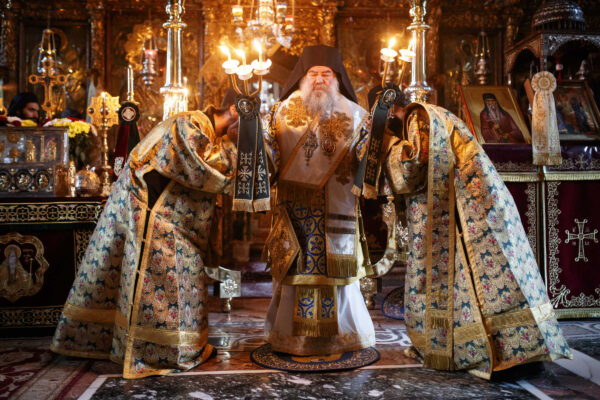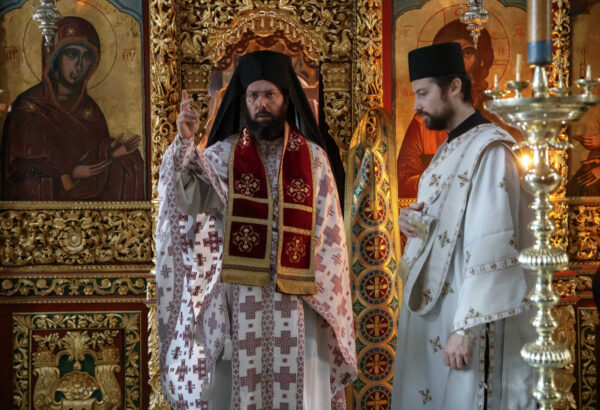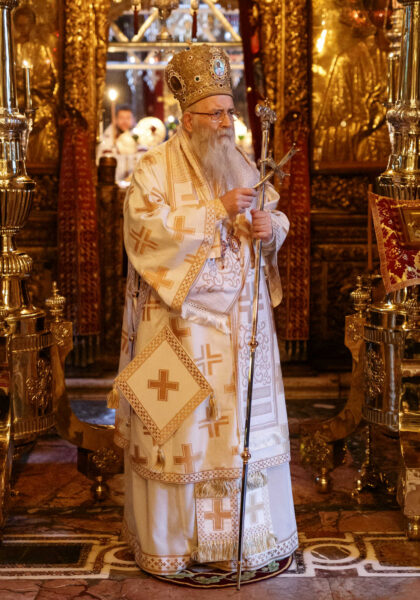The orthodox bishop
24 Φεβρουαρίου 2020
Outside of Church services, an Orthodox Bishop is recognizable by his wearing a traditional necklace-chain and medallion depicting a small, circular icon of the Saviour or of the Theotokos (the Mother of our Lord). This necklace and medallion is called an Engolpion, worn over the Bishop’s heart as a reminder that the Bishop must always bear in his heart our Lord and His mother, and to keep his heart pure.
Inside our Church services, the Bishops are more easily recognizable because of distinctive signs that clearly distinguish them from the other clerics who take part in the service. Such recognition lies in the specific vestments of the Bishop.
The omophorion
The first distinguishing sign of a Bishop’s vestments is the omophorion, a long and wide piece of textile material that is wrapped around the Bishop’s neck and shoulders, making up a complete revolution—as opposed to the epitrachelion of the priest, which is wrapped only in half. The omophorion is much wider than the priest’s epitrachelion or the deacon’s orarion, is usually decorated with crosses, and symbolizes the lost sheep that the Good Shepherd carries on His shoulders. It is the symbol of the bishop’s spiritual and ecclesial authority.
The miter
Also visible is the miter (the crown) that was taken over from the Byzantine emperors. It is, in fact, their crown, designed today in a stylized form because, after the fall of Constantinople (under the Turks), the Patriarch was forced to assume part of the Emperor’s responsibilities toward the Greek people. Usually, only the first bishop in the rank wears a miter when serving. Even if the miter is specific to the bishops, it can also (rarely and, more so, historically) be granted to archimandrites and archpriests. The miter symbolizes the crown of thorns on the head of our Lord Jesus Christ.
The sakkos
The sakkos is a relatively large-sleeved coat that ends slightly below the knee with a cross on the back. In the beginning, Bishops wore a phelonion like the priests, but adorned with many crosses, called polystavrion (“many crosses”). The sakkos was the official clothing of the Byzantine emperor and it was especially offered by the emperor to certain patriarchs as a sign of personal favor. In time, around the 13th century, the sakkos became worn by all the patriarchs and, after the fall of Constantinople, the sakkos became worn by all the bishops, regardless of rank. The sakkos represent the tunic of disgrace that Jesus wore during His mockery and judgment. Traditionally, on the sakkos are attached bells, following the Old Testament tradition according to the indications related to the High Priest (Exodus 28: 33-34; 39: 25-26).
The Church staff
The Bishop’s Church staff is the sign of the pastoral service and is significantly longer than the more-plainly presented staff carried by the Bishop outside of Church services. At the end of the Church staff are two snakes, reminiscent of the bronze serpent raised in the desert by Moses, which now symbolizes the crucifixion of the Lord by which we are saved from sin.
As a simple priest
If the Orthodox Bishop serves as a simple priest: from the above distinctive signs, the Bishop will have only the omophorion worn as an epitrachelion.
In the following photographs, you may see the following bishops serving at Vatopedi Monastery, Mount Athos: Metropolitan Ierotheos Vlachos of Nafpaktos, serving as a protos; Metropolitan Athanasios of Lemessos, serving the same liturgy as the second archbishop; Metropolitan Joseph of Prikonisou, with a sakkos with polystavrion and Church staff; and Metropolitan Arsenios of Austria, serving as a simple priest, having just the omophorion, a phelonion with polystavrion and koukoulion at the chapel of Holy Belt (Vatopedi Monastery).

Metropolitan Athanasios of Lemessos, serving the same liturgy as the second archbishop

Metropolitan Arsenios of Austria, serving as a simple priest, having just the omophorion, a phelonion with polystavrion and koukoulion

Metropolitan Joseph of Prikonisou, with a sakkos with polystavrion and Church staff
Πηγή: www.orthodoxianewsagency.gr



